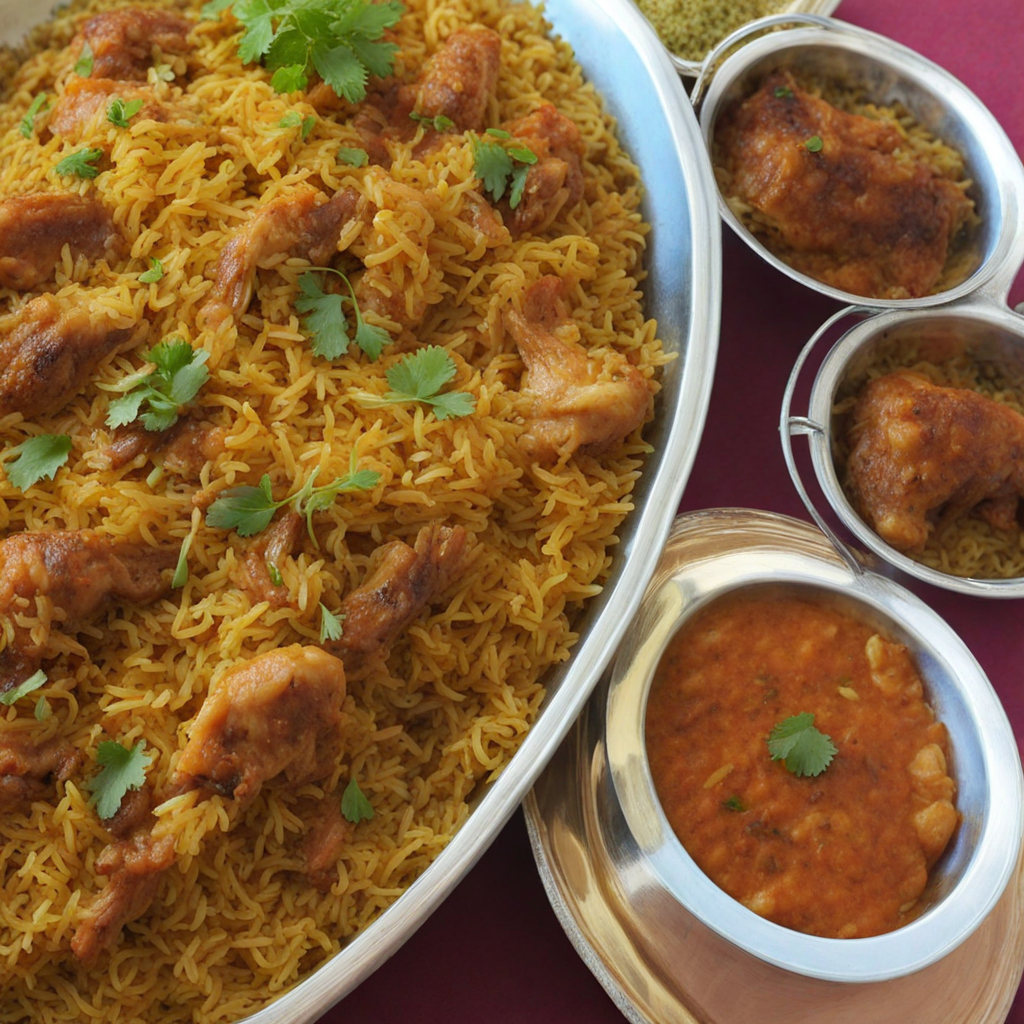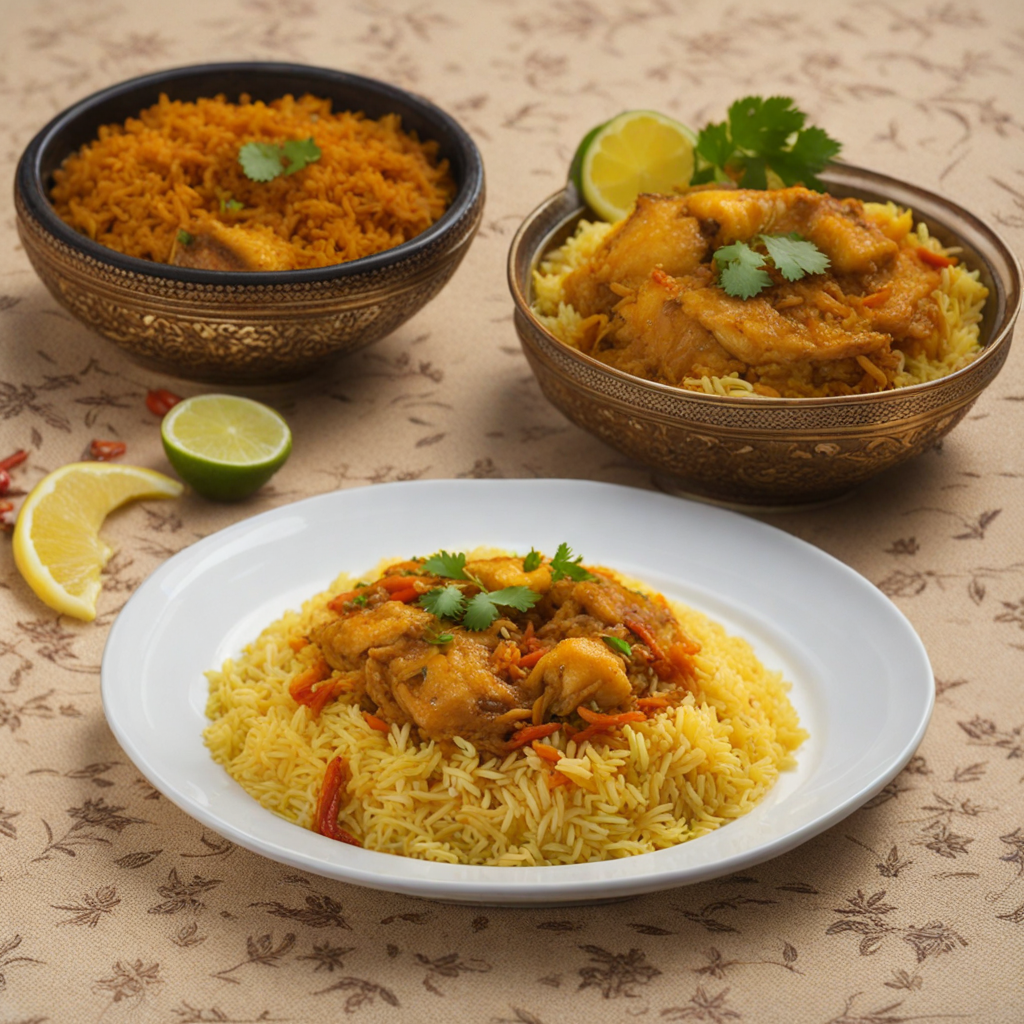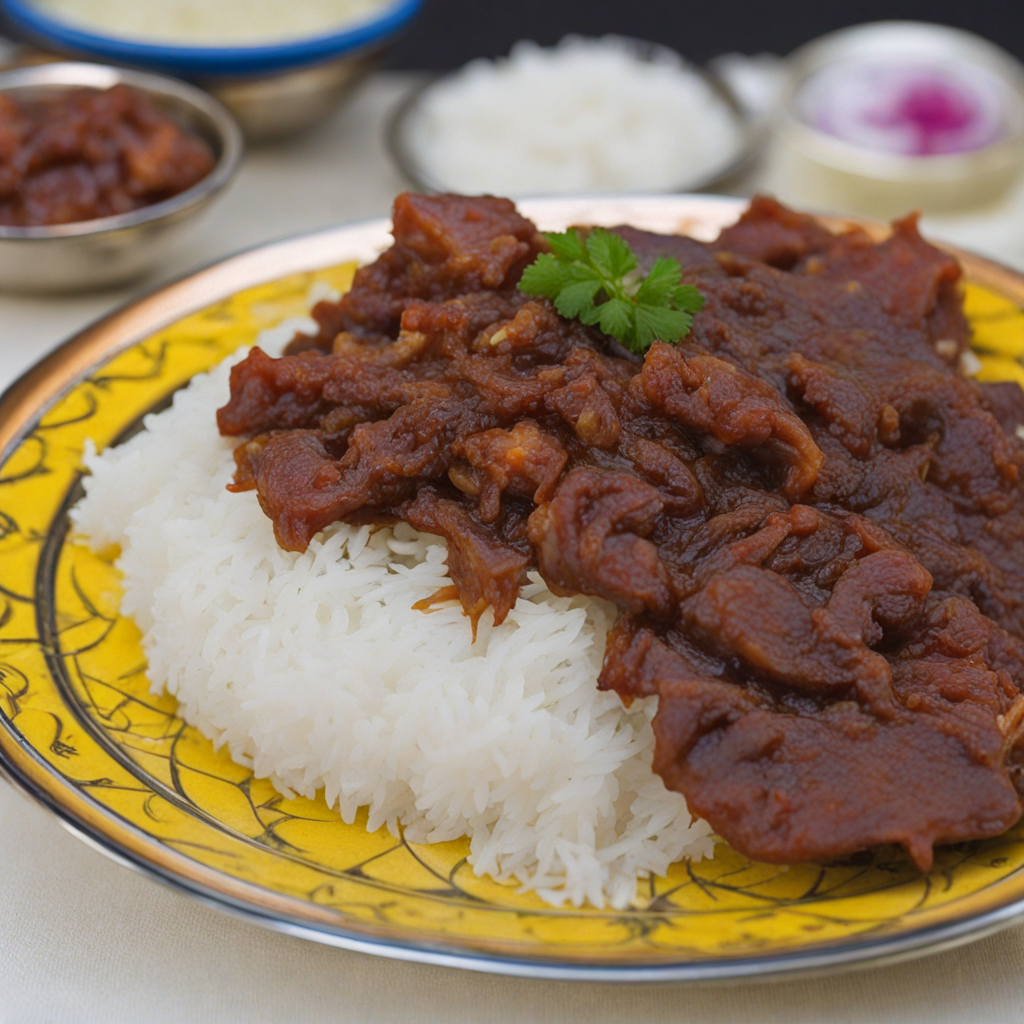Surbiyaan
Surbiyaan is a delightful and aromatic rice dish that hails from the coastal nation of Djibouti, where culinary traditions are deeply influenced by various cultures, including Somali and Arab. This vibrant dish is characterized by its fluffy basmati rice, which is often infused with a rich blend of spices such as cumin, coriander, and cardamom. The cooking process typically involves sautéing onions and garlic until golden, followed by the addition of marinated meats—commonly chicken or lamb—that simmer with the spices, creating a fragrant base that permeates the rice. One of the standout features of Surbiyaan is its colorful presentation, often garnished with fried raisins, nuts, and fresh herbs, which not only add texture but also a touch of sweetness and crunch. The layering of the rice and meat creates a visually appealing dish that is perfect for gatherings and celebrations. The combination of spices and the slow-cooked meat results in a savory and slightly spicy flavor profile that is warm and inviting, making it a comforting meal for any occasion. Surbiyaan is typically served with a side of tangy salads or yogurt, which balance the richness of the dish and enhance its overall experience. Each bite offers a medley of flavors that reflect the diverse culinary landscape of Djibouti, inviting food lovers to explore the delightful fusion of tastes that this dish embodies. It is not just a meal; it’s a celebration of cultural heritage, making Surbiyaan a must-try for anyone looking to indulge in the unique and delicious flavors of Djibouti.
How It Became This Dish
The History of سربيان (Sarbiyan) in Djibouti #### Origins Sarbiyan, a dish deeply rooted in the culinary traditions of Djibouti, has a history that intertwines with the region's rich cultural tapestry. Djibouti, situated at the horn of Africa, has long been a melting pot of various cultures, largely due to its strategic location along ancient trade routes. The combination of Arab, Somali, French, and Ethiopian influences has shaped not only the people but also their cuisine. The word "Sarbiyan" is derived from the Arabic word "sarb," which refers to the act of cooking rice. It is believed that the dish's origins can be traced back to the introduction of rice to the region through trade, particularly during the medieval period when Arab traders began to establish routes along the coast of the Red Sea and the Gulf of Aden. As rice became a staple in the local diet, it was adapted to suit the flavors and ingredients available in Djibouti, leading to the creation of Sarbiyan. #### Cultural Significance Sarbiyan is more than just a meal; it is a symbol of hospitality and community in Djibouti. Traditionally served during significant celebrations and gatherings, such as weddings, religious holidays, and family reunions, it plays a central role in fostering social bonds. The preparation and consumption of Sarbiyan is often a communal affair, where family and friends come together to cook, serve, and share the dish, reinforcing the values of unity and togetherness. In Djiboutian culture, food often serves as a medium for storytelling and the transmission of history. Sarbiyan, with its rich flavors and aromas, evokes memories of home and heritage. The dish carries with it the essence of Djibouti’s identity, encapsulating the country’s diverse influences while remaining distinctly local. It is a celebration of the land, the people, and their intertwined histories. #### Ingredients and Preparation Sarbiyan is typically made with basmati or long-grain rice, which is cooked with a medley of spices, vegetables, and meat, usually chicken or lamb. The key spices include cumin, coriander, cardamom, and cinnamon, reflecting the Arabian influence on Djiboutian cuisine. The dish often features a rich, flavorful broth that is used to cook the rice, allowing it to absorb the spices and flavors fully. The preparation of Sarbiyan is an art form in itself. Traditionally, the rice is first parboiled, then layered with marinated meat and vegetables, and finally steamed to perfection. Some variations may include the addition of raisins or nuts, which add a touch of sweetness and texture. The final product is a colorful and aromatic dish that tantalizes the senses and highlights the culinary skills of the cook. #### Evolution Over Time Over the years, Sarbiyan has evolved, influenced by various culinary trends and the changing lifestyles of Djiboutians. In the past, the dish was often prepared for special occasions due to the time and effort involved in cooking it. However, as urbanization and globalization have taken root, the accessibility of ingredients has increased, and modern cooking techniques have made it easier for people to prepare Sarbiyan at home. In contemporary Djibouti, Sarbiyan is not only enjoyed during formal gatherings but has also found its way into everyday meals. Street vendors and local eateries now offer Sarbiyan as a quick and satisfying option for those on the go, making it a beloved comfort food for many. This adaptation reflects a broader trend in Djiboutian cuisine, where traditional dishes are modernized to fit the fast-paced lifestyle of urban living. Moreover, with the rise of tourism in Djibouti, Sarbiyan has gained recognition beyond its borders. Tourists seeking authentic experiences are drawn to local dishes, and Sarbiyan has become a culinary ambassador for Djiboutian culture. Restaurants catering to international visitors often highlight Sarbiyan on their menus, showcasing its rich flavors and cultural significance. #### Globalization and Fusion As globalization continues to influence culinary practices worldwide, Sarbiyan has also embraced elements from other cuisines. Chefs and home cooks are experimenting with new ingredients and techniques, leading to innovative variations of the traditional dish. For instance, some may incorporate local seafood or exotic spices to create a fusion of flavors that reflects the diverse culinary landscape of Djibouti. Social media has played a significant role in this evolution, as food enthusiasts share their Sarbiyan recipes and experiences online. This exchange of ideas has fostered a sense of community among food lovers, encouraging cross-cultural appreciation and inspiring a new generation to explore their culinary heritage. #### Conclusion Sarbiyan is more than just a dish; it is a reflection of Djibouti’s rich cultural heritage and the resilience of its people. From its origins rooted in ancient trade to its modern adaptations, Sarbiyan embodies the spirit of hospitality, community, and culinary creativity. As Djibouti continues to embrace change while honoring its traditions, Sarbiyan remains a cherished symbol of the nation’s identity, bringing people together through the simple act of sharing a meal. In celebrating Sarbiyan, we celebrate the history, culture, and unity of Djibouti—an enduring testament to the power of food to connect us all. Whether enjoyed at a vibrant market stall or at a family gathering, Sarbiyan is a dish that continues to evolve while remaining a vital part of Djiboutian life.
You may like
Discover local flavors from Djibouti







